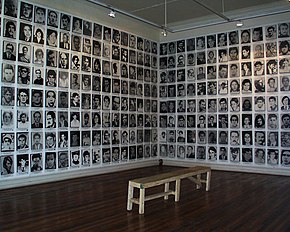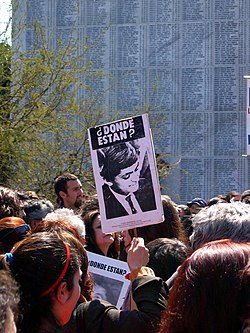
Disappeared Detainees (Spanish: detenidos desaparecidos, DD. DD) is the term commonly used in Latin American countries to refer to the victims of kidnappings, usually taken to clandestine detention and torture centers, and crimes of forced disappearance, committed by various authoritarian military dictatorships during the 1970s and 1980s, and officially recognized, among others, by the governments of Argentina (1984) and Chile (1991).
Origin
| This section needs additional citations for verification. Please help improve this article by adding citations to reliable sources in this section. Unsourced material may be challenged and removed. Find sources: "detenido desaparecido" origin – news · newspapers · books · scholar · JSTOR (December 2023) (Learn how and when to remove this message) |

The simultaneous and massive appearance of this practice in various countries is considered to be the result of the common training provided by the U.S. Defense department at its School of the Americas in Panama. Antecedents of the forced eliminations and disappearances of political prisoners can be found in the Hitler dictatorship, which issued an ordinance (the Nacht und Nebel Decree, Night and Fog) applicable to captured English "Commandos" who were summarily executed without any record of their capture and execution.
Procedures
Main article: Clandestine detention center (Argentina)
The first step of this method consisted in the apprehension of the victims by law enforcement agencies, undercover secret police or paramilitary groups with official support. Sometimes the arrest was conducted with a certain formality; at other times it took on the appearance and brutality of a kidnapping.
Once arrested, the victim was usually subjected to physical and psychological torture sessions, while official channels of information denied relatives any knowledge of the person's whereabouts. The "detainees pointed the finger at complete strangers for protecting their companions. They hoped that the interrogators would quickly determine their innocence, although often the opposite was true: the detainees could not provide them with any information because they had no information to offer, which led to even greater torture". Finally, the prisoner was killed and his body was buried clandestinely. In some cases, the hostages survived and are considered "ex-disappeared detainees".
The hiding of the corpse was often carried out with the support of aerial vehicles, such as airplanes and helicopters, from which the bodies were thrown into the sea or into inaccessible areas.
Consequences
| This section does not cite any sources. Please help improve this section by adding citations to reliable sources. Unsourced material may be challenged and removed. Find sources: "detenidos desaparecidos" impact – news · newspapers · books · scholar · JSTOR (December 2023) (Learn how and when to remove this message) |

The massive disappearance of people implied long years of search and suffering for their relatives (causing severe anguish due to long unfinished mourning). This situation led relatives to organize themselves to demand information, justice and the search for the corpses by filing habeas corpus petitions in the courts. For example, in Chile, the Association of Families of the Detained-Disappeared and the Agrupación de Familiares de Ejecutados Políticos [es] acted; and in Argentina, the organization of Mothers of Plaza de Mayo and the Mothers of Plaza de Mayo (founder organisation) [es].
This illegal practice forced, with the passage of time and the fall of the dictatorships that carried it out, the creation of official bodies to clarify these crimes (such as the National Commission on the Disappearance of Persons in Argentina or the Commission for Peace [es] in Uruguay) and of a new criminal offense in many of the countries affected, where today the forced disappearance of persons is explicitly punished, in addition to international human rights treaties and conventions.
See also
References
- ^ Rousseaux, Fabiana; Duhalde, Eduardo Luis (2015). El ex-detenido desaparecido como testigo de los juicios por crímenes de lesa humanidad (in Spanish). Galerna. ISBN 978-987460440-8.
- "SOA Watch". Archived from the original on February 3, 2010. Retrieved January 27, 2010.
- http://www.ankulegi.org/wp-content/uploads/2012/03/0003Robben.pdf p. 70
- "ASOCIACION DE EX DETENIDOS DESAPARECIDOS - BUENOS AIRES - ARGENTINA" (in Spanish). 2016-07-01. Archived from the original on July 1, 2016. Retrieved December 10, 2016.
- Report of the Comisión Nacional sobre la Desaparición Forzada de Personas (CONADEP) (in Spanish)
External links
- Ministerio del Interior, Chile. INFORME DE LA COMISIÓN NACIONAL DE VERDAD Y RECONCILIACIÓN (INFORME RETTIG), 8 de febrero de 1991 (in Spanish).
- INFORME DE LA COMISIÓN NACIONAL SOBRE LA DESAPARICIÓN DE PERSONAS (CONADEP), septiembre de 1984 (in Spanish).
- Nota de Prensa, Inauguración del Monumento a las Víctimas del Terrorismo de Estado, Buenos Aires, Argentina (in Spanish).